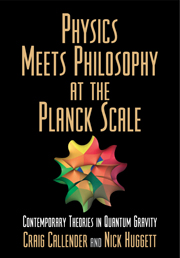Book contents
- Frontmatter
- Contents
- Preface
- 1 Introduction
- Part I Theories of Quantum Gravity and their Philosophical Dimensions
- Part II Strings
- 5 Reflections on the fate of spacetime
- 6 A philosopher looks at string theory
- 7 Black holes, dumb holes, and entropy
- Part III Topological Quantum Field Theory
- Part IV Quantum Gravity and the Interpretation of General Relativity
- Part V Quantum Gravity and the Interpretation of Quantum Mechanics
- References
- Notes on contributors
- Index
5 - Reflections on the fate of spacetime
Published online by Cambridge University Press: 15 December 2009
- Frontmatter
- Contents
- Preface
- 1 Introduction
- Part I Theories of Quantum Gravity and their Philosophical Dimensions
- Part II Strings
- 5 Reflections on the fate of spacetime
- 6 A philosopher looks at string theory
- 7 Black holes, dumb holes, and entropy
- Part III Topological Quantum Field Theory
- Part IV Quantum Gravity and the Interpretation of General Relativity
- Part V Quantum Gravity and the Interpretation of Quantum Mechanics
- References
- Notes on contributors
- Index
Summary
Introduction
Our basic ideas about physics went through several upheavals early this century. Quantum mechanics taught us that the classical notions of the position and velocity of a particle were only approximations of the truth. With general relativity, spacetime became a dynamical variable, curving in response to mass and energy. Contemporary developments in theoretical physics suggest that another revolution may be in progress, through which a new source of ‘fuzziness’ may enter physics, and spacetime itself may be reinterpreted as an approximate, derived concept (see Fig. 5.1). In this article I survey some of these developments.
Let us begin our excursion by reviewing a few facts about ordinary quantum field theory. Much of what we know about field theory comes from perturbation theory; perturbation theory can be described by means of Feynman diagrams, or graphs, which are used to calculate scattering amplitudes. Textbooks give efficient algorithms for evaluating the amplitude derived from a diagram. But let us think about a Feynman diagram intuitively, as Feynman did, as representing a history of a spacetime process in which particles interact by the branching and rejoining of their worldlines. For instance, Fig. 5.2 shows two incident particles, coming in at a and b, and two outgoing particles, at c and d. These particles branch and rejoin at spacetime events labelled x, y, z, and w in the figure.
According to Feynman, to calculate a scattering amplitude one sums over all possible arrangements of particles branching and rejoining.
- Type
- Chapter
- Information
- Physics Meets Philosophy at the Planck ScaleContemporary Theories in Quantum Gravity, pp. 125 - 137Publisher: Cambridge University PressPrint publication year: 2001
- 4
- Cited by



